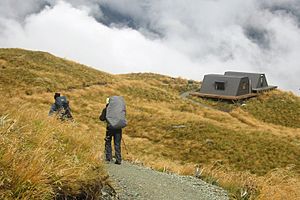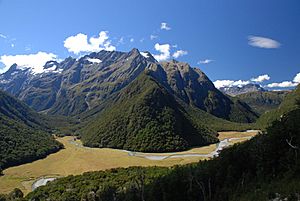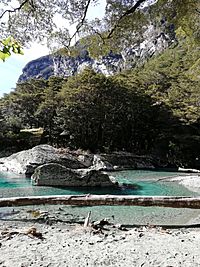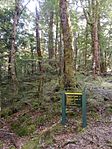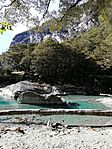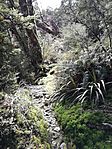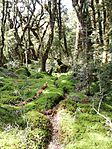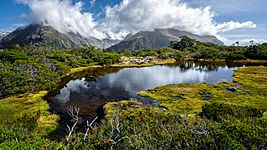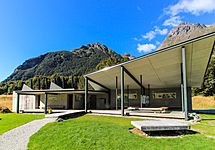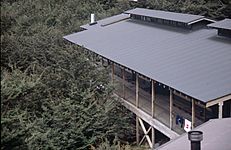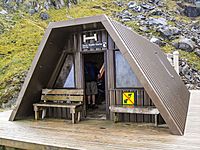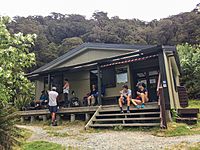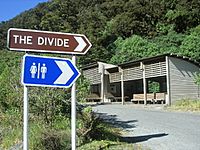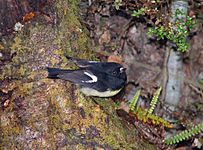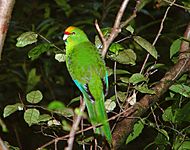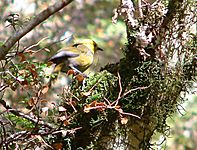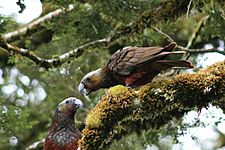Routeburn Track facts for kids
Quick facts for kids Routeburn Track |
|
|---|---|

Key Summit as viewed from track
|
|
| Length | 32 km (20 mi) |
| Location | Fiordland National Park & Mount Aspiring National Park, New Zealand |
| Designation | New Zealand Great Walk |
| Trailheads | Routeburn Shelter, The Divide |
| Use | Tramping, Trail running |
| Highest point | near Harris Saddle 1,300 m (4,300 ft) |
| Lowest point | Routeburn Shelter, 477 m (1,565 ft) |
| Difficulty | medium |
| Season | Summer to autumn |
| Months | Late October to late April. Possible to walk in winter months too, but for experienced hikers only |
| Sights | Alpine views, lakes, forests, tussocklands, rivers, waterfalls |
| Hazards | Hypothermia, sunburn, high winds, rocks, snow, rain & avalanche risks |
| Surface | dirt, rock |
| Website | Department of Conservation |
The Routeburn Track is a world-renowned, 32 km tramping (hiking) track found in the South Island of New Zealand. The track can be done in either direction, starting on the Queenstown side of the Southern Alps, at the northern end of Lake Wakatipu or on the Te Anau side, at the Divide, several kilometres from the Homer Tunnel to Milford Sound.
The New Zealand Department of Conservation classifies this track as a Great Walk and maintains four huts along the track: Routeburn Flats Hut, Routeburn Falls Hut, Lake Mackenzie Hut, and Lake Howden Hut; in addition there is an emergency shelter at Harris Saddle. The track overlaps two National Parks; the Mount Aspiring National Park and Fiordland National Parks with the border and highest point being the Harris Saddle. There is access to another tramping area called the Greenstone and Caples Tracks from Lake Howden Hut near The Divide.
This area gets much less rain than the Milford Sound, and the forests are very different, especially on the eastern side of the saddle, which due to less rainfall is predominantly made up of New Zealand red beech and mountain beech, with relatively few ferns. The track spends a long time on the high ridges around Harris Saddle, with great long-distance views in many directions. The track has a long history of use dating back to the 1880s.
Tramping
Access to the Routeburn Track is not as tightly controlled as the Milford Track. Camping is allowed, though both huts and camping spaces must be booked in advance during peak season. There is a choice of which direction to go, and which huts to stay in. On the western side, most trampers stay at the Lake Mackenzie Hut, but on the eastern side, one can stay at the Falls Hut or Flats Hut. The Falls Hut is more popular, since staying there breaks up the climb to the saddle better, especially coming from the east. Camping is not allowed at Falls Hut. In the winter, the Falls Hut is commonly used as a ski touring base for easy access into the Serpentine Range and beyond.
As it is a relatively short track, much of the Routeburn Track is also accessible to day hikers. Key Summit (918m), on the western end is the site of a popular viewpoint and nature walk not far from the roadway, and the return to the Routeburn Flats Hut are both commonly done in a day.
Because you usually tramp the track from one end and finish it at the other transport can be challenging: the distance between trackheads is 340 km (a 5-hour drive). Transport options include bus, hitchhiking or car relocation. Some people get around this by doing a key swap with another walker going in the opposite direction.
Track profile
The route
Starting at Routeburn Road end, the track crosses a suspension bridge and starts as a gentle sidle up the true left hand side of the Routeburn River. The well graded track crosses Sugarloaf stream (start/finish of the classic five pass tramp) and the Bridal Veil waterfall and leads to a steeper climb that goes above the gorge to Forge Flats, the site of an early blacksmith camp. The valley opens up soon after this point, re-crosses the Routeburn and heads towards the Routeburn flats.
Leaving the Routeburn Flats hut, the track climbs steadily towards the Routeburn Falls Hut, passing Eagle Bluff and Emily creek, and across the site of a major slip in 1994. This slip has cleared the beech forest from around the track affording views back down the Routeburn as well as up the Routeburn (north branch) towards Mt. Somnus (2293m) and Mt Momus (2148m).
Past the Routeburn Falls hut, the track becomes narrower and more technical as it climbs past Lake Harris. Passing under bluffs as it sidles around Lake Harris and there is a view up 'the valley of trolls' towards Lake Wilson (the source of the Routeburn) and the Serpentine Range.
Above Lake Harris, the track arrives at the Harris shelter. The popular side trip to Conical Hill (1515m) is commonly done from the shelter, and offers a 360 degree view of the area. From the saddle (1255m), the track traverses southwards along the Hollyford face, with expansive views out to Martins Bay and the Tasman Sea, before a descent of a steep series of zig-zags to Lake Mackenzie Hut.
From Lake Mackenzie, the track crosses a small flat before climbing to the tree line. It then gradually descends past the 'Orchard', an open grassy area dotted with ribbonwood trees, to Earland Falls (174m high). The route passes under the falls but in times of heavy flow an alternative route exists dropping below the falls to a small bridge. The track continues its gradual descent down to Howden Hut. From here the track branches off towards the Greenstone and Caples Tracks which create a semi-circuit back towards Glenorchy, the Routeburn continuing past Key Summit to The Divide road end and the end of the track.
New Zealand Mountain Safety Council's video on the Routeburn Track
| Point | Coordinates (links to map & photo sources) |
Notes |
|---|---|---|
| Routeburn Shelter | 44°43′05″S 168°16′27″E / 44.718018°S 168.274247°E | 477m. Start/end of track. |
| Routeburn Flats Hut and Camp | 44°43′32″S 168°12′53″E / 44.725466°S 168.214794°E | 685m. |
| Route Burn (North Branch) | 44°41′26″S 168°12′28″E / 44.690586°S 168.207799°E | 856m. Side trip. |
| Routeburn Falls Hut | 44°43′33″S 168°11′54″E / 44.725819°S 168.198392°E | 972m. |
| Harris Saddle | 44°43′37″S 168°10′13″E / 44.726954°S 168.170337°E | 1255m. Highest point of main track near saddle is 1300m. |
| Conical Hill | 44°43′18″S 168°10′09″E / 44.721734°S 168.169096°E | 1515m. Highest point of entire track. Side trip. |
| Lake Mackenzie Hut | 44°46′03″S 168°10′24″E / 44.767611°S 168.173198°E | 892m. |
| Lake Mackenzie Camp | 44°45′50″S 168°10′35″E / 44.763969°S 168.176411°E | 900m. Side trip. |
| Lake Howden Hut | 44°48′56″S 168°08′06″E / 44.815632°S 168.135036°E | 688m. |
| Key Summit | 44°48′53″S 168°07′40″E / 44.814847°S 168.127886°E | 918m. Side trip. |
| State Highway 94 / The Divide | 44°49′30″S 168°07′02″E / 44.824875°S 168.117152°E | 532m. Start/end of track. |
Side Trips
Various side trips can be found off the main route that are available between both ends of the Routeburn Track, and some trampers incorporate these into a full crossing while others use the main track as an access point to explore the various options available. Starting from the Routeburn Shelter and ending at The Divide some of the Side Trips available are:
Nature Walk
A short loop track to the left of the main trail with much signage mainly made for day walkers from the Routeburn Shelter end.
Rockburn Track and Sugarloaf Track
An advanced tramping track to the right of the trail that links back toward the Lake Sylvan walk and Sylvan campsite as well as the Route Burn North Branch.
Forge Flat
A small rest point in sand next to the Routeburn River.
Route Burn North Brach
An advanced multi-day tramping track accessed over the river from Routeburn Flats Hut; this route links with Rockburn Track and Sugarloaf Track.
Emily Pass
An unmarked advanced tramping route which via Emily Pass allows access back down to Lake Mackenzie or via Fraser Creek access into the Caples Track.
Lake Wilson
Just before the Harris Saddle Shelter and after Lake Harris to the right is an unmarked advanced tramping route which leads to Lake Wilson.
Conical Hill
From the Harris Shelter a steep route takes you to the top of Conical Hill and is the highest marked trail on the Routeburn Track, a wide vista can be seen from the top.
Deadmans Track
Another advanced tramping track on the right just after the Harris Shelter but this time marked leads down to the Hollyford Road.
Lake Mackenzie Campsite and Split Rock
To the left of Mackenzie Hut a track beside the lake leads to the Lake Mackenzie campsite first and Split Rock second which is a large rock with a split large enough to walk through.
Howden Campsite and Greenstone and Caples Tracks
The track to the left of Lake Howden Hut leads initially to the Howden Campsite and later to the Greenstone and Caples Tracks.
Pass Creek Track
A marked track which leads from the right of Howden Hut down to the Hollyford Road. This track was originally a cattle track for Davey Gunn who would take his cattle from the Hollyford to the Greenstone Valley and back.
Key Summit
The most popular side trip in terms of numbers as this track to the left (or right if approaching from the carpark) is a day walk accessible from The Divide. The track continues and then ends to become an unmarked route along the Livingstone Mountains eventually leading down a spur to McKellar Hut on the Greenstone Track.
Huts and Shelters
Birdlife
There are a variety of New Zealand native birds to be seen on and near the track. Parrots like the kaka and kea can often be seen and heard and are quite large in comparison to the yellow-crowned parakeet. Often seen are the common and friendly South Island robin and fantail. Smaller birds that are conspicuous are the bellbird, grey warbler, brown creeper, South Island tomtit and the rare yellowhead. Hard to see is the tiny rifleman and New Zealand's smallest bird Rock Wren.
Images for kids



